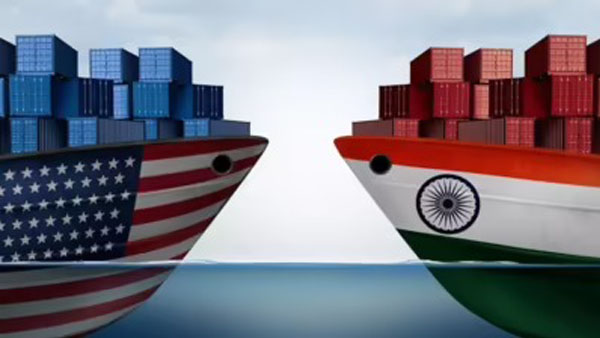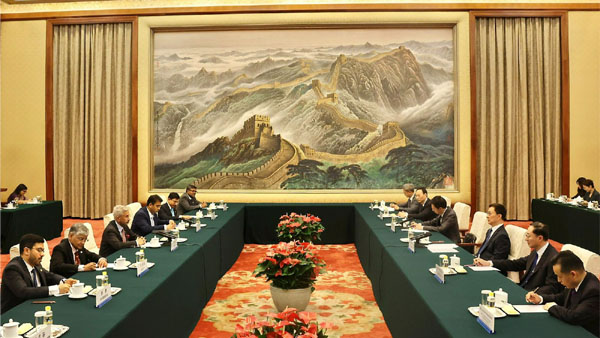New Delhi, Jul 14 : Indian exports to the US will become more competitive following imposition of higher tariffs by the Trump administration on countries, including China, Canada, and Mexico, NITI Aayog said in a report on Monday.
The Aayog in its third edition of ‘Trade Watch Quarterly’ said there will be significant opportunities for India in the US markets both in terms of the number of products and volume of the US market.
“India is expected to gain competitiveness in 22 out of the top 30 categories (HS 2 level), representing a market size of USD 2,285.2 billion,” the Aayog said.
It further explained that China, Canada, and Mexico are the leading exporters to the US in these categories, therefore higher tariffs on these countries at 30 per cent, 35 per cent, and 25 per cent, respectively, will enhance India’s competitiveness.
The thematic focus of this quarter’s edition is the evolving US trade and tariff structures and their implications for India’s export competitiveness.
“India’s relative tariff advantage vis-a-vis major competitors presents a strategic window to expand market share in the US market, especially in sectors such as pharmaceuticals, textiles, and electrical machinery, among others,” the Aayog said, adding that the evolving global trade environment demands agile policymaking to capitalise on new trade alignments.
The government think tank said India’s competitiveness will remain unchanged in 6 out of 30 categories, amounting for 32.8 per cent exports to the US and 26 per cent of the US total imports, amounting to USD 26.5 billion.
While for six product categories at HS 2 level, India faces a higher average tariff (between 1-3 per cent) which can be negotiated with the US, the Aayog said, “In 78 products, accounting for 52 per cent of India’s exports and 26 per cent share in total US imports, India is expected to gain competitiveness.”
For 17 products (accounting for 28 per cent of India’s export to the US) out of the top 100 products at the HS-4 level, the Aayog said India’s competitiveness remains unchanged due to no change in tariff differential.
The Aayog also pointed out that “India stands to gain in sectors with high tariff gaps vs China, Canada and Mexico — minerals and fuels, apparel, electronics, plastics, furniture, and seafoods in a USD 1,265-billion market”.
To support MSMEs and boost export competitiveness, it said the government could consider expanding production-linked incentive (PLI) schemes to include labour-intensive sectors such as leather, footwear, furniture, and handicrafts.
The Aayog also called for rationalising electricity tariffs by reducing cross-subsidisation for industrial users and promoting renewable energy adoption could help lower operational costs and enhance the global competitiveness of Indian manufacturers.
It suggested that building on the model of the India-UK agreement, India should pursue a services-oriented trade deal with the US, placing strong emphasis on key sectors such as information technology, financial services, professional services, and education.
“The agreement should include robust provisions for digital trade, creating a framework for enhanced cross-border service delivery,” the Aayog said.
Meanwhile, an Indian commerce ministry team has reached Washington for another round of talks on the proposed bilateral trade agreement (BTA), which will begin on Monday.
The visit assumes significance as both sides have to iron out issues in sectors like agriculture and automobiles. It is also important as the US has further postponed the imposition of additional tariffs on several countries, including India, until August 1.
Earlier this month, the Indian team was in Washington for talks, with negotiations taking place from June 26 to July 2. The team has once again reached the US for negotiations.
India has hardened its position on the US demand for duty concessions on agri and dairy products. New Delhi has, so far, not given any duty concessions to any of its trading partners in a free trade agreement in the dairy sector.
India is seeking the removal of this additional tariff (26 per cent). It is also seeking the easing of tariffs on steel and aluminium (50 per cent) and the auto (25 per cent) sectors.
Against these, India has reserved its right under the WTO (World Trade Organization) norms to impose retaliatory duties.
US President Donald Trump announced heavy tariffs on a number of countries, including India, on April 2. However, it was soon postponed for 90 days until July 9 and later to August 1.
From July 7, the Trump administration has issued tariff letters to a number of its trading partners, including Bangladesh, Indonesia, Japan, South Korea, Malaysia, Thailand, South Africa, Bosnia and Herzegovina, Cambodia, Kazakhstan, Laos, Serbia, and Tunisia.
The US wants duty concessions on certain industrial goods, automobiles, especially electric vehicles, wines, petrochemical products, and agri goods, like dairy items, apples, tree nuts, and genetically modified crops.
On the other hand, India is seeking duty concessions for labour-intensive sectors, such as textiles, gems and jewellery, leather goods, garments, plastics, chemicals, shrimp, oil seeds, grapes, and bananas in the proposed trade pact.
The two countries are looking to conclude talks for the first tranche of the proposed bilateral trade agreement (BTA) by fall (September-October) this year. Before that, they are looking for an interim trade pact. (PTI)



